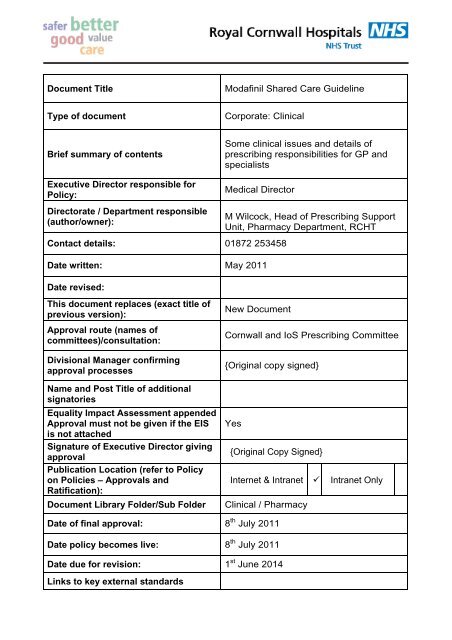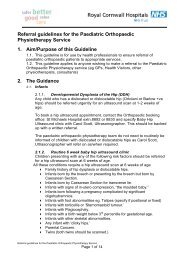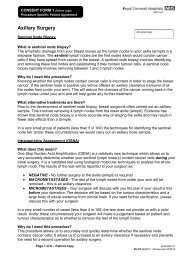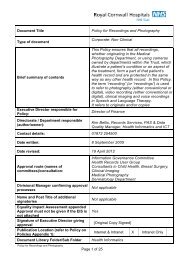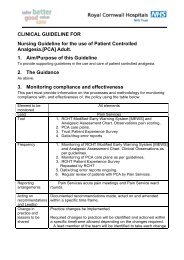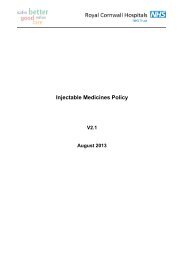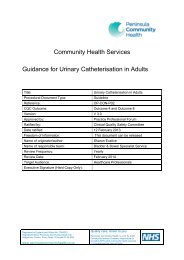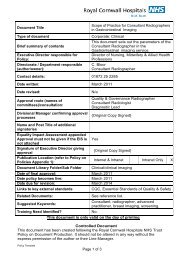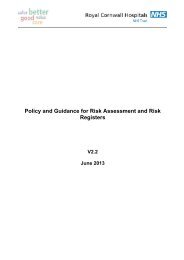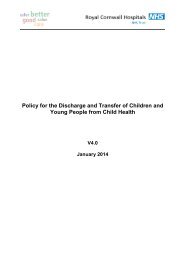Modafinil Shared Care Guideline - the Royal Cornwall Hospitals ...
Modafinil Shared Care Guideline - the Royal Cornwall Hospitals ...
Modafinil Shared Care Guideline - the Royal Cornwall Hospitals ...
- No tags were found...
You also want an ePaper? Increase the reach of your titles
YUMPU automatically turns print PDFs into web optimized ePapers that Google loves.
Version Control TableDateVersionNoMay 2011 V1.0Summary of ChangesFinal amendments approved; EIACompleted; document publishedChanges Made by(Name and Job Title)Mike Wilcock, Head ofPrescribing SupportUnit, PharmacyDepartment, RCHTAll or part of this document can be released under <strong>the</strong> Freedom of Information Act2000This document is to be retained for 10 years from <strong>the</strong> date of expiry.
CORNWALL AND IOS HEALTH COMMUNITY SHARED CARE GUIDELINEMODAFINILThis shared care guideline sets out details for sharing careof adult patients prescribed <strong>Modafinil</strong>. These guidelinesprovide limited information necessary to aid in <strong>the</strong>treatment of <strong>the</strong>se patients. As with all shared careguidelines <strong>the</strong>y highlight relevant prescribing issues butshould be used in conjunction with <strong>the</strong> BNF, ABPIsummary of product characteristics and do not replace<strong>the</strong>m.BACKGROUND / INDICATIONS FOR THE PURPOSESOF THIS GUIDELINE:<strong>Modafinil</strong> is licensed for adults for <strong>the</strong> treatment ofexcessive sleepiness associated with narcolepsy with orwithout cataplexy. Excessive sleepiness is defined asdifficulty maintaining wakefulness and an increasedlikelihood of falling asleep in inappropriate situationsA diagnosis of narcolepsy should be made according to<strong>the</strong> International Classification of Sleep Disordersguideline. Such an evaluation usually consists, in additionto <strong>the</strong> patient's history, sleep measurements testing in alaboratory setting and exclusion of o<strong>the</strong>r possible causesof <strong>the</strong> observed hypersomnia.<strong>Modafinil</strong>, in similar dosages to those below, is also usedoff-license for: <strong>the</strong> hypersomnia that may occasionally be seenin chronic fatigue syndrome (CFS/ME),sleepiness and fatigue associated with multiplesclerosis, sleepiness associated with myotonic dystrophy (acommon form of adult muscular dystrophy). and sleepiness associated with idiopathichypersomnolence (debilitating sleepinessthroughout <strong>the</strong> day without a diagnosed medicalreason).Note that modafinil is no longer indicated for shift-workersleep disorder and obstructive sleep apnoea.Narcolepsy is a rare (1: 50,000) disorder of sleep. It isneurological disorder marked by uncontrollable attacks ofdaytime sleepiness and also quite often characterised bycataplexy (sudden loss of muscle power triggered byemotion).The sleep pattern typically seen in CFS/ME is of poorquality, disrupted and unrefreshing night-time sleep, whichmay lead to compensatory day time sleeping; usualapproaches to improving night-time sleep (sleep hygiene;low-dose tricyclics or related agents) are indicated, andmodafinil is not appropriate in this setting. However, avery few CFS/ME patients have disabling hypersomnia,despite good night-time sleep; it is for <strong>the</strong>se patients thatmodafinil may be considered, as it has proved helpful andwell tolerated in clinical experience. A starting dose of100mg in <strong>the</strong> morning is appropriate, as some CFS/MEpatients may be more sensitive to <strong>the</strong> effects ofmedication.DOSAGETreatment should be initiated by or under <strong>the</strong> supervisionof a physician with appropriate knowledge of indicateddisorders.The recommended starting dose is 200mg a day, or100mg a day for CFS/ME patients. The total daily dosemay be taken as a single dose in <strong>the</strong> morning or as twodoses in <strong>the</strong> morning and at noon, according to physicianassessment of <strong>the</strong> patient and <strong>the</strong> patient's response.Doses of up to 400mg in one or two divided doses can beused in patients with insufficient response to <strong>the</strong> initialmodafinil dose.Doses should be halved in patients with severe hepatic orrenal failure (100 – 200mg / day).INITIATION & MONITORINGA baseline electrocardiogram should be done beforetreatment initiation. Patients with abnormal findings shouldbe fur<strong>the</strong>r evaluated by specialists before modafiniltreatment can be initiatedCardiovascular function—especially blood pressure andheart rate—should be monitored after one to two monthsof treatment, and <strong>the</strong>n regularly annually, or morefrequently if <strong>the</strong>re are significant risk factors. <strong>Modafinil</strong>should be discontinued in patients who developarrhythmia or moderate to severe hypertension, andshould not be restarted until <strong>the</strong> condition has beenadequately evaluated and treated.CONTRAINDICATIONSPregnancy and breast feeding; use in children;uncontrolled moderate to severe hypertension and inpatients with cardiac arrhythmias; patients with a history ofleft ventricular hypertrophy or cor pulmonale; and inpatients with mitral valve prolapse who have experienced<strong>the</strong> mitral valve prolapse syndrome when previouslyreceiving CNS stimulants.PRECAUTIONS - caution is advised as follows:Patients with major anxiety should only receive treatmentin a specialist unit.<strong>Modafinil</strong> should be used with caution in patients with ahistory of: Psychosis, depression, or mania<strong>Modafinil</strong> SCG Page 1 of 3Authors: Neurology Team. Endorsed by <strong>Cornwall</strong> & IoS Prescribing CommitteeDate of Issue: May 2011 Review Date June 2014
CORNWALL & IOS HEALTH COMMUNITY SHARED CARE GUIDELINE Abuse of alcohol, drugs, or illicit substancesSuch patients should be monitored closely and advised toreport any suspected adverse behaviours or thoughts.These patients should be assessed immediately andtreatment stopped if appropriate.<strong>Modafinil</strong> should be discontinued and not restarted incases of psychiatric disorders such as suicidal ideation.Sexually active women of childbearing potential should beestablished on a contraceptive programme before takingmodafinil.Whilst studies with modafinil have demonstrated a lowpotential for dependence, <strong>the</strong> possibility of dependencewith long-term use cannot be entirely excluded.Serious rash, including Stevens-Johnson Syndrome, ToxicEpidermal Necrolysis and Drug Rash with Eosinophiliaand Systemic Symptoms: Serious skin rashes requiringhospitalization and discontinuation of treatment have beenreported in adults and children in association with <strong>the</strong> useof modafinil occurring within 1 to 5 weeks after treatmentinitiation [isolated cases have been reported afterprolonged treatment (e.g. 3 months)]. <strong>Modafinil</strong> should bediscontinued at <strong>the</strong> first sign of rash and not restartedunless <strong>the</strong> rash is clearly not drug – relatedSIDE EFFECTSBelow are some of <strong>the</strong> more common side effects. Pleasenote that this list is NOT exhaustive and that it isrecommended that <strong>the</strong> SPC and BNF should be consultedfor a more comprehensive list:: - decreased appetite,nervousness, insomnia, anxiety, depression, abnormalthinking, confusion, headache, dizziness, somnolence,paraes<strong>the</strong>sia, blurred vision, tachycardia, palpitation,vasodilatation, abdominal pain, nausea, dry mouth,diarrhoea, dyspepsia, constipation, as<strong>the</strong>nia. Patients wi<strong>the</strong>xcessive sleepiness, including those taking modafinilshould be frequently reassessed for <strong>the</strong>ir degree ofsleepiness and, if appropriate, advised to avoid driving orany o<strong>the</strong>r potentially dangerous activity.COMMON / SIGNIFICANT DRUG INTERACTIONSThere is a low potential for drug-drug interactions. TheSPC and BNF should be consulted for a morecomprehensive list of potential drug interactions.<strong>Modafinil</strong> accelerates <strong>the</strong> metabolism of oralcontraceptives leading to reduced contraceptiveeffectiveness hence alternative or concomitant methods ofcontraception are recommended. Adequate contraceptionwill require continuation of <strong>the</strong>se methods for two monthsafter stopping modafinilIn view of <strong>the</strong> enzyme inducing potential of modafinil, careshould be taken when co-administering with anticonvulsants.The clearance of warfarin may be decreased –prothombin times should be monitored regularly during <strong>the</strong>first two months and after changes in modafinil dosage.Blood levels of ciclosporin may be reducedPRODUCT INFORMATION<strong>Modafinil</strong> (Provigil) is available as a 100mg and 200mgtablets.REFERENCES Summary of Product Characteristicshttp://emc.medicines.org.uk/ British National Formulary www.bnf.org.ukCONTACTS (in hours) RCHT medicine information: 01872 252587Request for o<strong>the</strong>rformatsPlease ask if you wouldlike to receive this leafletin large print, braille, onCD or in any o<strong>the</strong>rlanguages. If you wouldlike <strong>the</strong> leaflet in analternative format pleasecontact <strong>the</strong> PALS team onpalsteam@ciospct.cornwall.nhs.uk or 0845 1708000<strong>Modafinil</strong> SCG Page 2 of 3Authors: Neurology Team. Endorsed by <strong>Cornwall</strong> & IoS Prescribing CommitteeDate of Issue: May 2011 Review Date: June 2014
CORNWALL & IOS HEALTH COMMUNITY SHARED CARE GUIDELINEAREAS OF RESPONSIBILITY FOR THE SHARING OF CAREThese are suggested ways in which <strong>the</strong> responsibilities for adult patients prescribed <strong>Modafinil</strong> can be sharedbetween <strong>the</strong> specialist and <strong>the</strong> general practitioners. GPs are invited to participate. An endorsement of a SCGby <strong>the</strong> CIPC means that prescribing in accordance with <strong>the</strong> SCG is suitable for primary care to undertake. If <strong>the</strong>GP is not confident to undertake <strong>the</strong>se roles, <strong>the</strong>n <strong>the</strong>y are under no obligation to do so. In such an event <strong>the</strong>total clinical responsibility for <strong>the</strong> patient for <strong>the</strong> diagnosed condition remains with <strong>the</strong> specialist. If a specialistasks <strong>the</strong> GP to prescribe this drug <strong>the</strong> GP should reply to this request as soon as practical. Sharing of careassumes communication between <strong>the</strong> specialist, GP and patient. The intention to share care should beexplained to <strong>the</strong> patient and be accepted by <strong>the</strong>m.In its guidelines on responsibility for prescribing (circular EL(91)127) between hospitals and GPs, <strong>the</strong>DH has advised that legal responsibility for prescribing lies with <strong>the</strong> doctor who signs <strong>the</strong> prescription.Specialist: To assess <strong>the</strong> patient and establish/confirm <strong>the</strong> diagnosis of hypersomnia, ensuring <strong>the</strong> suitability of <strong>the</strong>patient for modafinil. To undertake or arrange a baseline electrocardiogram before treatment initiation. Patients with abnormalfindings should be fur<strong>the</strong>r evaluated by specialists before modafinil treatment can be initiated. Prescribe modafinil until GP formally agrees to shared care, <strong>the</strong>n transfer prescribing ensuring patient has4 weeks supply. Review of treatment to assess benefit eg an annual review by a Consultant Sleep Specialist, after GP hastaken over <strong>the</strong> prescribing. Stop treatment at any appropriate time. Ensure clear arrangements for back-up advice and support. Reporting adverse events to <strong>the</strong> MHRA.General Practitioner: Reply to request for shared care as soon as practical. Prescribing following stabilisation of patient Monitoring of BP and heart rate in hypertensive patients after one to two months of treatment, and <strong>the</strong>nregularly annually, or more frequently if <strong>the</strong>re are significant risk factors. Discontinue in patients who experience any psychiatric symptoms and not restart. Discontinue at <strong>the</strong> first sign of rash and not restart. Monitoring patient’s overall health and well-being. Monitoring adverse effects and potential drug interactions and reporting to specialist as appropriate. Reporting adverse events to MHRA. Stopping treatment in <strong>the</strong> case of a severe adverse event or as per shared care guideline.Patient: Patients should be advised that modafinil is not a replacement for sleep and good sleep hygiene should bemaintained. Report any adverse effects to <strong>the</strong>ir GP and/or specialist whilst being treated with modafinil.BACK-UP ADVICE AND SUPPORT IS AVAILABLE FROM THE RELEVANT TEAM<strong>Modafinil</strong> SCG Page 3 of 3Authors: Neurology Team. Endorsed by <strong>Cornwall</strong> & IoS Prescribing CommitteeDate of Issue: May 2011 Review Date: June 2014
Appendix 1.Initial Equality Impact Assessment Screening FormName of service, strategy, policy or project (hereafter referred to as policy) to beassessed:<strong>Shared</strong> <strong>Care</strong> <strong>Guideline</strong> for <strong>Modafinil</strong>Directorate and service area:Is this a new or existing Procedure?PharmacyNewName of individual completingTelephone:assessment:Dan Thomas, Pharmaceutical Services 01726 627514Contracting Manager, CIoSPCT1. Procedure Aim* To provide information on prescribing of <strong>Modafinil</strong> toenable General Practitioners to take over prescribingresponsibility from secondary care.2. Procedure Objectives* To promote a consistent level of shared care betweenprimary and secondary care (in relation to RCHTcatchment area)3. Procedure – intendedOutcomes*Confident and competent prescribers, enabling medicinesto be access in a primary care setting.4. How will you measure<strong>the</strong> outcome?5. Who is intended tobenefit from <strong>the</strong>Procedure?6a. Is consultationrequired with <strong>the</strong>workforce, equalitygroups etc. around thisprocedure?If <strong>the</strong> guidelines is not well received, publicised andadopted, <strong>the</strong>n some GPs may not enter into shared carearrangements.General practitioners, hospital specialists and communitypharmacists – from understanding local guidance arounduse of <strong>the</strong>se medicines. Patients/carers, from being ableto access medicines from <strong>the</strong>ir GP.NOb. If yes, have <strong>the</strong>segroups been consulted?c. Please list any groupswho have been consultedabout this procedure.*Please see Glossary7. The ImpactPlease complete <strong>the</strong> following table using ticks. You should refer to <strong>the</strong> EIA guidancenotes for areas of possible impact and also <strong>the</strong> Glossary if needed.
Where you think that <strong>the</strong> policy could have a positive impact on any of <strong>the</strong> equalitygroup(s) like promoting equality and equal opportunities or improving relationswithin equality groups, tick <strong>the</strong> ‘Positive impact’ box. Where you think that <strong>the</strong> policy could have a negative impact on any of <strong>the</strong> equalitygroup(s) i.e. it could disadvantage <strong>the</strong>m, tick <strong>the</strong> ‘Negative impact’ box. Where you think that <strong>the</strong> policy has no impact on any of <strong>the</strong> equality group(s) listedbelow i.e. it has no effect currently on equality groups, tick <strong>the</strong> ‘No impact’ box.EqualityGroupAgePositiveImpactNegativeImpactNoImpactxReasons for decisionDisabilityxFaith andBeliefxGenderxRacexSexualOrientationxYou will need to continue to a full Equality Impact Assessment if <strong>the</strong> following havebeen highlighted: A negative impact and No consultation (this excludes any policies which have been identified as notrequiring consultation).8. If <strong>the</strong>re is no evidence that<strong>the</strong> policy promotes equality,equal opportunities or improvedrelations - could it be adaptedso that it does? How?Full statement of commitment to policy ofequal opportunities is included in <strong>the</strong> policyPlease sign and date this form.Keep one copy and send a copy to <strong>the</strong> Human Resources Team, c/o<strong>Royal</strong> <strong>Cornwall</strong> <strong>Hospitals</strong> NHS Trust, Human Resources Department, Lamorna House,Penventinnie Lane, Truro, <strong>Cornwall</strong>, TR1 3LJThey willarrange for a summary of <strong>the</strong> results to be published on <strong>the</strong> Trust’s web site.Signed _______Dan Thomas & Mike Wilcock_________________________________Date _____April 2011____________________________________


